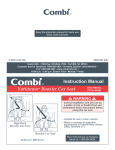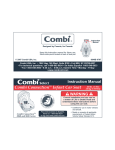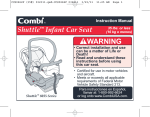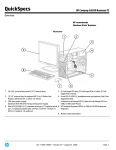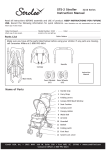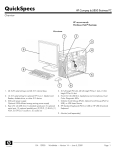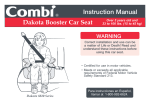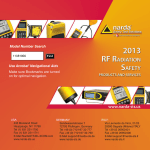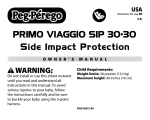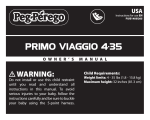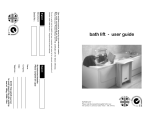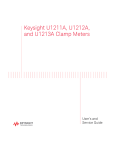Download Combi Victoria 8850 User's Manual
Transcript
Keep this instruction manual for future use. Store instruction manual in harness shield on back of seat. © 2004 Combi USA 8850B-06/04 (EN) Combi USA • 1962 Hwy 160 West, Suite 100 • Fort Mill, SC 29708 • Customer Service Telephone 1-800-992-6624 • Se Habla Español 1-803-548-6633 • Fax 1-803-548-3663 • www.combi-intl.com • 10:00 a.m. - 5:00 p.m. Eastern Time • Monday - Friday Instruction Manual Victoria™ Convertible Car Seat 5 to 40 lbs. (2.3 to 18 kg) h PRESS Victoria™ 8850 Series fo L o w er A nc or rC H il d r e n T LA CH rs sa nd T eth e WARNING Correct installation and use can be a matter of Life or Death! Read and understand these instructions before using this car seat. • Certified for use in motor vehicles and aircraft. • Meets or exceeds all applicable requirements of Federal Motor Vehicle Safety Standard 213. Para instrucciones en Español, llamar al: 1-800-992-6624. 1 Section 1 - Table of Contents Securing Child In Car Seat....................24 Section 1. Table of Contents....................................1 Section 10. Section 2. Warnings..............................................2 Section 3. Proper Use Check List............................3 Section 4. Victoria™ Car Seat Parts.........................4 Section 5. Use Recommendations...........................5 Section 6. Selecting A Vehicle Seating Location......7 Section 11. Operation and Adjustments 11a. Harness Use and Adjustment............26 11b. Changing Shoulder Harness Positions............................................27 11c. Infant Insert........................................31 11d. Recline Position Adjustment..............31 Section 7. LATCH System.......................................9 Section 12. Vehicle Seat Belts.................................32 Section 8. 8a. Rear-facing Installation Rear-facing Set-Up And Adjustment....................................10 Rear-facing Installation With LATCH..........................................11 Rear-facing Installation With Vehicle Seat Belt...........................14 Section 13. Rear-facing Belt Lock-off......................35 Section 14. Section 15. Section 16. Additional Information • Certification...................................36 • Aircraft Use...................................36 • Warm Weather..............................36 • Vehicle Seat Protection.................36 • Car Seat Useful Life......................36 • Instructions Manual Storage.........36 Care and Cleaning................................36 Registration Information.......................37 Section 17. Re-Use After A Crash............................37 Section 18. Limited Warranty...................................38 8b. 8c. Section 9. 9a. 9b. 9c. Forward-facing Installation Forward-facing Set-Up And Adjustment....................................16 Forward-facing Installation With LATCH..........................................17 Forward-facing Installation With Vehicle Seat Belt...........................21 Keep this instruction manual for future use. Store instruction manual in harness shield on back of seat. Section 2 - Warnings WARNING DEATH or SERIOUS INJURY can occur • Failure to follow these instructions and car seat labels can result in injury or death to a child from striking the vehicle’s interior during a sudden stop or crash. • Use only in a rear-facing position when using this car seat with an infant less than one year old and weighing less than 20 pounds (9 kg). • Use only with children who weigh between 5 and 40 pounds (2.3 and 18 kg) and whose height is between 19 and 40 inches (48 and 102 cm). • Discontinue use when child’s weight exceeds 40 pounds (18 kg) or shoulders are above the top shoulder belt slots. • Snugly adjust harness provided with the car seat around child. • Harness covers MUST be used when forward-facing. • For proper harness fit: - Infant insert must be used with small infants. - Shoulder belts MUST be through shoulder belt slots in infant insert. - Discontinue use of the infant insert when shoulder belts become too short to fit infant. • To prevent loose harness and risk of ejection, harness shield must be in place during use. • Secure this child restraint with the vehicle’s LATCH System if available or with a vehicle seat belt as shown in this manual. • LATCH System or vehicle seat belt MUST stay tightly adjusted around car seat at all times. • Secure the top anchor strap provided with this child restraint as specified in this instruction manual. • Securely belt this car seat in vehicle, even when not occupied. An unsecured car seat can injure other occupants in a crash. • Never leave child unattended, even when sleeping. • Strangulation Hazard: Child can strangle in loose harness straps. Never leave child in car seat when straps are loose or undone. • DO NOT use accessories or parts other than those provided by Combi USA or Strolee. Use of accessories or parts from other manufacturers could alter the performance of the car seat. • DO NOT allow any re-use of this car seat after a crash unless crash and car seat meet ALL conditions in “Re-use After A Crash” section of this manual. • DO NOT use this car seat if it is damaged, missing instructions, or missing parts. • Register your child restraint with the manufacturer. 2 3 Section 3 - Proper Use Check List • Proper use is required. Read and understand instructions and car seat labels. • Securely install car seat with LATCH System or vehicle seat belt and top tether strap. • • • Snugly adjust harness around child. • Do not use car seat rear-facing in vehicle front seating location with an air bag. • • • Secure children in back seat whenever possible. Need help installing your infant car seat? Contact one of the following sources to locate a child safety seat inspection station in your area: • Your vehicle dealer. • Call 1-866-SEAT CHECK (1-866-732-8243). Harness covers MUST be used when forward-facing. • Visit www.nhtsa.dot.gov and select “Child Seat Inspections”. Infants less than one year old and 20 lbs. (9 kg) must use car seat rear-facing. • Visit www.seatcheck.org. • Contact a certified child passenger safety technician in your area. To locate a certified “Child Passenger Safety” Technician in your area visit www.nhtsa.dot.gov and select “Child Passenger Safety” and then select “Technician Contact Locator”. Never leave child unattended. Do not allow anyone (babysitter, relatives, etc.) to use car seat without first reading and understanding all instructions and car seat labels. Proper Use Is Required: No car seat can guarantee protection from injury in every situation, but proper use helps reduce the risk of serious injury or death. Section 4 - Victoria™ Car Seat Parts Top Tether Hook Seat Pad Infant Insert Chest Clip Harness Cover LATCH Connector Storage Shoulder Harness Crotch Strap with Buckle Buckle Tongues LATCH Lower Anchor Belt and Connector Tummy Pad PRESS Seat Harness Adjuster Lever Seat Pad Para instrucciones en Español, llamar al: 1-800-992-6624. o PRESS Lo w r Anch e Rear-facing Belt Path Victoria™ 8850 Series 5 to 40 lbs. (2.3 to 18 kg) • Certified for use in motor vehicles and aircraft. • Meets or exceeds all applicable requirements of Federal Motor Vehicle Safety Standard 213. WARNING L AT C H rs Instruction Manual Seat Rear-facing Belt Lock-off Recline Lever (Red handle under front of seat) a n d T et h ers H il d r e n Victoria™ Convertible Car rC Harness Shield (Secured To Back Of Seat) Correct installation and use can be a matter of Life or Death! Read understand these instructions and before using this car seat. Harness Adjuster Strap fo Top Tether Strap Instruction Manual (Store In Harness Shield) Forward-facing Shoulder Belt Lock-off Forward-facing Belt Path 4 Rear-facing Belt Lock-off Storage Base Rear-facing Belt Lock-off 5 Section 5 - Use Recommendations WARNING DEATH or SERIOUS INJURY can occur • Children less than one year old and 20 lbs. (9 kg) must use this car seat rear-facing. Serious crippling injury or death can result if infant faces front of vehicle. Height and Weight Limits: This child restraint is designed for use only by children whose: - Weight is between 5 and 40 pounds (2.3 and 18 kg) and, - Height is between 19 and 40 inches (48 and 102 cm). Infants With Special Needs A preterm infant or low birth weight infant may be at special risk traveling reclined in a vehicle or aircraft. According to the American Academy of Pediatrics, these infants may be at increased risk of suffering breathing or other difficulties if improperly reclined or positioned in a car seat. Have your physician or hospital staff evaluate your infant in this car seat before you and your infant leave the hospital. If your infant is not able to travel in a reclined position, DO NOT use this car seat. Use a car bed for your infant. Rear-facing Use: 5 to 30 lbs. (2.3 to 13.6 kg) • Infants less than one year old and 20 lbs. (9 kg) MUST be rear-facing. • Infants or toddlers 20 to 30 lbs. (9 to 13.6 kg) may be rear-facing. The American Academy of Pediatrics recommends keeping children over 1 year of age rear-facing as long as possible. Rear-facing Use 5 lbs. (2.3 kg) 20 lbs. (9 kg) 30 lbs. (13.6 kg) 40 lbs. (18 kg) IMPORTANT: This car seat is certified for use rear-facing with children up to 30 lbs. (13.6 kg). However, some children approaching 30 lbs. (13.6 kg) may be too tall to fit comfortably rear-facing. When child can no longer comfortably fit and knees remain bent, child can use car seat forward-facing only if child is over one year old and 20 lbs. (9 kg) and can sit upright unassisted. Forward-facing Use: 20 to 40 lbs. (9 to 18 kg) • Toddlers 20 to 30 lbs. (9 to 13.6 kg), over one year of age, and who are capable of sitting upright unassisted may be forward-facing. If unable to sit unassisted, use rear-facing. • Toddlers 30 to 40 lbs. (13.6 to 18 kg) and up to 40 inches (102 cm) tall MUST be forward-facing. 5 lbs. (2.3 kg) 20 lbs. (9 kg) 30 lbs. (13.6 kg) 40 lbs. (18 kg) Forward-facing Use One Year or Older WARNING DEATH or SERIOUS INJURY can occur • Harness covers MUST be used when forward-facing. • To avoid injuries from whiplash, top of child’s ears must be below top edge of car seat. • Child’s shoulders MUST not be above top harness slots. 6 7 Section 6 - Selecting A Vehicle Seating Location WARNING DEATH or SERIOUS INJURY can occur • DO NOT use this child restraint rear-facing in a vehicle front seating location with an air bag. Child’s head and neck may be seriously injured when an inflating air bag hits back of child restraint. • Never put a car seat in a vehicle front seating location unless recommended by vehicle owner’s manual. 1 The National Highway Traffic Safety Administration (NHTSA) alerts vehicle owners that according to accident statistics, 2 NO coloque el asiento infantil para el automóvil orientado hacia atrás en el asiento delantero del vehículo que tenga una bolsa neumática de seguridad. El niño podría MORIR O SUFRIR LESIONES GRAVES. El asiento trasero es el lugar más seguro para los niños de 12 años o menores. 3 Seats Which Face Rear Of Vehicle WARNING children up to age 12 are safer when properly restrained in the rear seating positions rather than the front seating positions. Refer to vehicle owner’s manual for car seat installation instructions for your vehicle. - Use car seat in a rear vehicle seat location whenever possible. - Never use a car seat in a front seat location unless recommended by vehicle owner’s manual. - For vehicles with air bags, always follow child restraint installation information provided in vehicle owner’s manual. DO NOT place rear-facing child seat on front seat with air bag. DEATH OR SERIOUS INJURY can occur. DO NOT use car seat rear-facing on front seat with an air bag. The back seat is the safest place for children 12 and under. For a toddler over one year old and forward-facing, if a vehicle front seat location with an air bag must be used, follow the vehicle manufacturer’s instructions for child restraint use and move the vehicle seat back as far as possible. Vehicle seats: DO NOT use this Car Seat on the following types of vehicle seats: Seats Which Face Sides Of Vehicle Options For Securing A Car Seat: This car seat can be secured to a vehicle using the new LATCH System or a vehicle seat belt. 1. LATCH System: LATCH stands for Lower Anchors and Tethers for CHildren. Starting with model year 2003 vehicles are equipped with LATCH Systems. See “LATCH System” section for more information. Check vehicle owner’s manual to determine if your vehicle has the LATCH System that may be identified with the symbol in fig. c. (fig. c) Some vehicle owner’s manuals may identify the LATCH System as “ISOFIX”. An ISOFIX System can be used in the same way as the LATCH System. If your vehicle has the LATCH System, the LATCH System should be used whenever possible. 2. Vehicle Seat Belt and Top Tether Strap: If your vehicle does not have the LATCH System, the car seat MUST be secured to the vehicle using a vehicle seat belt and top tether strap as required. Check vehicle owner’s manual for seating locations recommended for car seat use and location of top tether anchorages. Top Tether Information: If a top tether anchor is not available in your vehicle, the car seat MUST be secured with only the vehicle seat belt until a top tether anchor can be installed. For those passenger vehicles or buses where top tether anchors are not available, the car seat may be used without the top tether provided a secure installation can be achieved. NOTE: Top tether is NOT used in the rear-facing position. When not in use, store top tether and LATCH lower anchor belt by snapping onto back of base (fig. d). 8 (fig. d) 9 Section 7 - LATCH System 3 LATCH System On This Car Seat: The LATCH System on the Victoria Car Seat consists of a lower anchor belt 1 with lower anchor connectors 2 and for forward-facing use, a top tether strap with tether hook 3 (fig. a). Rear-facing car seat installation typically uses only the lower anchor belt 1 with lower anchor connectors 2 (fig. b), no top tether. 2 1 (fig. a) Securing Car Seat To Vehicle: The lower anchor connectors 2 and top tether hook 3 on the car seat connect to the LATCH System in a vehicle. LATCH System In Vehicles: Child restraint anchorage system or LATCH System in the vehicle consists of two lower anchors 4 located at the vehicle seat bight 5 and a top tether anchor 6 (fig. c). Refer to vehicle owner’s manual for seating locations which have the LATCH System. 2 1 (fig. b) 6 Lower anchors may not be visible in some vehicles. Lower anchors that are not visible are located below a solid color round dot on the vehicle upholstery or a round dot with a picture of a car seat in the center as shown in fig. d. 4 The vehicle manufacturer may provide funnel guides to separate the vehicle seat cushions providing easier access to the lower anchorage. See vehicle owner’s manual. 5 (fig. d) (fig. c) Section 8 - Rear-facing Installation 8a. Rear-facing Set-Up And Adjustment Rear-facing For Use 5 to 30 Pounds (2.3 to 13.6 kg) WARNING DEATH or SERIOUS INJURY can occur • DO NOT use this car seat rear-facing in a vehicle front seating location with an air bag. • LATCH or vehicle seat belt MUST be routed though rear-facing belt path when using car seat rear-facing. • Rear-facing car seat must be properly reclined: - Too reclined can result in injury or ejection. - Too upright can result in breathing difficulties. • For proper harness fit: - Infant insert must be used with small infants. - Shoulder belts MUST be through shoulder belt slots in infant insert. - Discontinue use of the infant insert when shoulder belts become too short to fit infant. The Victoria Car Seat is color coded to identify adjustment positions and vehicle belt path locations for both rear-facing and forward-facing use. Rear-facing adjustments and vehicle belt path are color coded with blue. Forward-facing adjustments and vehicle belt path are color coded with red. Middle Harness Strap Slots 1. Infants less than one year old and 20 lbs. (9 kg) MUST be rear-facing. 2. Adjust the seat recline into rear-facing, full recline position #1. To change recline position, see “Recline Position Adjustment” section. NOTE: Use only recline position #1 for rear-facing. 3. Shoulder harness position: a. For rear-facing, shoulder harness MUST be through slots at or below the shoulders of the infant. b. Use only the middle and lowest sets of harness strap slots rear-facing (fig. a). To change shoulder harness slots, see”Changing Harness Position” section. (fig. a) 4. Infant insert must be used for small infants. To install infant insert, see “Infant Insert” Lowest Harness section. Strap Slots 10 11 8b. Rear-facing Installation With LATCH WARNING DEATH or SERIOUS INJURY can occur • LATCH belt MUST stay tightly adjusted around car seat at all times. • Only use the car seat LATCH System in vehicle seating locations designated by the vehicle manufacturer for use with LATCH and that have an anchor spacing of 11 inches (280 mm). • LATCH connectors must be secured to the vehicle LATCH anchors only. Connection to other vehicle anchors or vehicle components could result in the anchor tearing free in a crash. • Never attach more than one lower anchor connector to a vehicle lower anchor unless recommended by the vehicle owner’s manual for that vehicle. 1 Refer to vehicle owner’s manual to identify the seating locations with LATCH System. Select the seating location to be used and locate the vehicle lower anchors at the seat bight (fig. a). LATCH Anchorages with 11 inch (280 mm) spacing may not be available in your vehicle in the rear center seating position. If use of the rear center position is preferred, use the vehicle seat belt to secure the car seat. See “Rear-facing Installation With Vehicle Seat Belt” section. Lower Anchors 2 After selecting a seating location, if vehicle seat back is adjustable, adjust seat back into most (fig. a) upright position. 3 Route the lower anchor belt through the rear-facing belt path identified by blue “Belt Here” arrows. - Remove lower anchor belt and hook-on connectors from their storage location on back of base (fig. b). - Pull entire lower anchor belt out on one side of car seat. Check that LATCH belts are not wrapped around shoulder harness adjuster strap. - Lengthen lower anchor belt by tipping belt adjuster and pulling lower anchor belt back through adjuster (fig. c). - Route lower anchor belt through rear-facing belt path in seat by inserting the end of the lower anchor belt with the belt adjuster into the belt path opening in seat identified by the blue “Belt Here” arrow and routing out through the rear-facing belt opening on opposite side of seat. - Center lower anchor belt and check that it is not twisted. 4 With seat adjusted into reclined position #1, place car seat rear-facing in the vehicle Lower Anchor Connectors (fig. b) Pull Lower Anchor Belt Belt Adjuster seat location selected with rear-facing belt path toward vehicle seat back and centered between the vehicle lower anchors (fig. d). (fig. c) 5 Connect lower anchor connectors to vehicle lower anchors. - With hook-on connector opening facing down 1 , position the opening of the connector over the vehicle lower anchor. Push down 2 and then pull out 3 on the connector to lock it onto the vehicle anchor (fig. e). You should hear a click. Rear-facing Belt Path - Pull on connector to be sure it is locked onto the anchor. - Repeat for connector on opposite side. 1 2 3 12 (fig. e) BELT HERE (fig. d) 13 6 Tighten lower anchor belt to secure the car seat. - Press down in center of car seat to depress the vehicle cushion and pull free end of lower anchor belt to tighten belt (fig. f). 7 Check recline angle of car seat. Recline reference line on side of seat MUST be horizontal (fig. g). If recline reference line is not horizontal, place tightly rolled up towel, blanket or firm foam (pool noodle) under end of car seat base contacting vehicle seat back (fig. g). (fig. f) If car seat can not be adjusted to make line horizontal: 1. Try a different seating position. 2. Do not use this car seat. Recline Reference Line NOTE: Vehicle must be parked on horizontal surface and child in car seat when checking recline angle of car seat. 8 Check for secure installation. Gripping car seat at top of armrest, pull car seat front to back and left to right to check for secure installation (fig. h). LATCH belt MUST stay tight. - If LATCH belt does not stay tight or car seat can not be securely installed, try a different LATCH location or use the vehicle’s seat belt to secure the car seat. Recheck recline angle of car seat. Adjust if necessary (see step 7). Towel or Pool Noodle (fig. g) Removal Of Car Seat Installed With LATCH: 1 Loosen lower anchor belt by tipping adjuster and pulling out lower anchor belt. - Pressing down in center of car seat to reduce tension on lower anchor belt will make it easier to loosen lower anchor belt. 3 2 Remove hook-on connectors from vehicle anchors. 2 - Press and hold the connector retainer spring 1 . - Push connector in, then rotate connector 2 , and pull out 3 to unhook from the vehicle anchor (fig. i). If the connector can’t be rotated, push in and lift the connector to unhook from the vehicle anchor. - Repeat to remove hook-on connector on opposite side. 1 (fig. h) (fig. i) Storage Of Lower Anchor Belt And Connectors: When not using the LATCH System, store the lower anchor belt and hook-on connectors by removing lower anchor belt and connectors from rear-facing belt path and snapping hook-on connectors onto LATCH connector storage locations on back of base (fig. j). Pull on free end of lower anchor belt to tighten. Lower Anchor Connectors LATCH Connector Storage Top Tether Storage: Store top tether on back of base when using car seat rear-facing. (fig. j) 8c. Rear-facing Installation With Vehicle Seat Belt WARNING DEATH or SERIOUS INJURY can occur • Not all vehicle seat belts can be used with this car seat. Read vehicle owner’s manual and “Vehicle Seat Belts” section in this manual. • Vehicle seat belt MUST stay tightly adjusted around car seat at all times. If vehicle seat belt does not stay tight, read the vehicle owner’s manual and “Vehicle Seat Belts” section in this manual. 1 Refer to vehicle owner’s manual to identify the seating locations which can be used with a car seat. Check for specific instructions for car seat use. 2 After selecting a seating location, if vehicle seat back is adjustable, adjust seat back into most upright position. 3 With car seat adjusted into recline position #1, place car seat rear-facing in the vehicle seat location selected with rear-facing belt path toward vehicle seat back (fig. a). 14 Rear-facing Belt Path (fig. a) 15 4 Thread vehicle lap belt or vehicle lap and shoulder belts through the rear-facing belt path in the seat (fig. b): - Thread vehicle seat belt through rear-facing belt path openings identified by the blue “Belt Here” arrows. - Buckle seat belt and remove any slack in the vehicle seat belt. Be sure vehicle seat belt is not twisted. 5 Tighten vehicle seat belt to secure the car seat. (fig. b) - Press down in center of car seat to depress the vehicle cushion while tightening vehicle seat belt (fig. c). 6 Check recline angle of car seat. Recline reference line on side of seat MUST be horizontal (fig. d). If recline reference line is not horizontal, place tightly rolled up towel, blanket or firm foam (pool noodle) under end of car seat base contacting vehicle seat back (fig. d). If car seat can not be adjusted to make line horizontal: 1. Try a different seating position. 2. Do not use this car seat. NOTE: Vehicle must be parked on horizontal surface and child in car seat when checking angle of car seat. (fig. c) 7 Check for secure installation. Gripping car seat at top of armrest, pull car seat front to back and left to right to check for secure installation (fig. e). Vehicle lap belt MUST stay tight. - If vehicle lap belt does not stay tight or car seat can not be securely installed, see vehicle owner’s manual, “Vehicle Seat Belts” section or move to a different seating location. Recheck recline angle of car seat. Adjust if necessary (see step 6). Removal Of Car Seat Installed With Vehicle Seat Belt: Towel or Pool Noodle Unbuckle vehicle seat belt. - Pressing down in center of car seat to reduce tension on vehicle seat belt will make it easier to loosen vehicle seat belt. Remove vehicle seat belt from belt path. (fig. e) (fig. d) Recline Reference Line Section 9 - Forward-facing Installation 9a.Forward-facing Set-Up And Adjustment Forward-facing For Use 20 to 40 Pounds (9 to 18 kg) WARNING DEATH or SERIOUS INJURY can occur • Children less than one year old and 20 lbs. (9 kg) MUST use this car seat rear-facing. Serious crippling injury or death can result if infant faces front of vehicle. • Harness covers MUST be used when forward-facing. • For proper harness fit: - Shoulder belts MUST be through shoulder belt slots in infant insert. - Discontinue use of the infant insert when shoulder belts become too short to fit infant. • LATCH or vehicle seat belt MUST be routed though forward-facing belt path when using car seat forward-facing. The Victoria Car Seat is color coded to identify adjustment positions and vehicle belt path locations for both rear-facing and forward-facing use. Forward-facing adjustments and the vehicle belt path are color coded with red. Rear-facing adjustments and the vehicle belt path are color coded with blue. 1. Infants MUST be at least one year old and 20 lbs. (9 kg) to be forward-facing. 2. Shoulder harness position: Top Harness a. Use only the middle and top two sets of harness strap slots forward-facing (fig. a). Strap Slots b. Harness covers MUST be used when forward-facing. c. Shoulder harness MUST be through slots at or above shoulders of child. To change shoulder harness slots, see “Changing Harness Position” section. 3. Seat recline: a. Use only recline positions #2, 3, or 4 when using car seat forward-facing. b. Seat recline position can be adjusted between positions without unsecuring vehicle seat belt. To change reline position, see “Recline Position Adjustment” section. 4. Infant insert: a. To install or remove infant insert, see “Infant Insert” section. (fig. a) b. Discontinue use of infant insert when shoulder belts become too short to fit child. Middle Harness Strap Slots 16 17 9b.Forward-facing Installation With LATCH WARNING DEATH or SERIOUS INJURY can occur • LATCH belt MUST stay tightly adjusted around car seat at all times. • Only use the car seat LATCH System in vehicle seating positions designated by the vehicle manufacturer for use with LATCH and have anchor spacing of 11 inches (280 mm). • LATCH connectors must be secured to the vehicle LATCH anchors only. Connection to other vehicle anchors or vehicle components could result in the anchor tearing free in a crash. • Never attach more than one lower anchor connector or top tether hook to a vehicle anchor unless recommended in the vehicle owner’s manual. 1 Refer to vehicle owner’s manual to identify the seating locations with LATCH System. Select the Top Tether Anchor seating location to be used and locate the vehicle lower anchors at the seat bight and top tether anchor (fig. a). LATCH Anchorages with 11 inch (280 mm) spacing may not be available in your vehicle in the rear center seating position. If use of the rear center position is preferred, use the vehicle seat belt to secure the car seat. See “Forward-facing Installation With Vehicle Lower Seat Belt” section. Anchors 2 After selecting a seating location, if vehicle seat back is adjustable, adjust seat back into most upright position. (fig. a) 3 Route the lower anchor belt through the forward-facing belt path identified by red Lower Anchor Connectors “Belt Here” arrows. - Adjust car seat into recline position #1 for better access while installing the car seat. - Remove lower anchor belt and connectors from their storage location on back of base (fig. b). - Pull entire lower anchor belt out on one side of car seat. Check that LATCH straps are not wrapped around harness adjustment strap. - Lengthen lower anchor belt by tipping belt adjuster and pulling lower anchor belt back through adjuster (fig. c). - Route lower anchor belt through car seat by inserting one end into space between back of seat and front of base. Pull through to opposite side. - Position the lower anchor belt in the forward-facing belt path by placing the lower anchor belt between raised ribs in forward-facing belt path identified by Lower the red “Belt Here” arrows (fig. d). Anchor Belt - Center lower anchor belt and check that it is not twisted. 4 Place car seat forward-facing in the vehicle seat location selected with forward-facing belt path toward vehicle seat back and centered between the vehicle lower anchors (fig. e). (fig. b) Pull Belt Adjuster (fig. c) (fig. d) 18 (fig. e) Forward-facing Belt Path 19 5 Connect lower anchor connectors to vehicle lower anchors. - With hook-on connector opening facing down 1 , position the opening of the connector over the vehicle lower anchor. Push down 2 and then pull out 3 on the connector to lock it onto the vehicle anchor (fig. f). You should hear a click. - Pull on connector to be sure it is locked onto the anchor. - Repeat for connector on opposite side. 1 2 6 Tighten lower anchor belt to secure the car seat. 3 - Press down in center of car seat to depress the vehicle cushion and pull free end of lower anchor belt to tighten belt (fig. g). (fig. f) 7 Check for secure installation. Gripping car seat at top of armrest, pull car seat front to back and left to right to check for secure installation (fig. h). LATCH belt MUST stay tight. - If LATCH belt does not stay tight or car seat can not be securely installed, try a different LATCH location or use the vehicle’s seat belt to secure the car seat. 8 Adjust car seat to desired recline position #2, 3 or 4. - To change recline position, see “Recline Position Adjustment” section. - Seat recline position can be adjusted between positions without unsecuring vehicle seat belt. NOTE: Use only position #2, 3 or 4 for forward-facing. (fig. g) 9 Attach top tether hook (A) to vehicle top tether anchor hardware (B) (fig. i) and pull strap to tighten top tether removing any slack. - If top tether anchor (B) is not available in vehicle, see vehicle owner’s manual or Top Tether Information in “Selecting A Vehicle Seating Location” section. Pull to tighten (A) (B) (fig. h (fig. i) Belt Adjuster Removal Of Car Seat Installed With LATCH: 1 Tip belt adjuster to loosen top tether strap (fig. j). 2 Depress retainer spring 1 and unhook 2 tether hook from vehicle top tether anchor (fig. k). (fig. j) 3 Loosen lower anchor belt by tipping adjuster and pulling out lower anchor belt. - Pressing down in center of car seat to reduce tension on lower anchor belt will make it easier to loosen lower anchor belt. 4 Remove hook-on connectors from vehicle lower anchors. 2 Retainer Spring - Press and hold the connector retainer spring 1 . Tether Hook - Push connector in, then rotate connector 2 , and pull out 3 to unhook from the vehicle anchor (fig. l). If the connector can’t be rotated, push in and lift the connector to unhook from the vehicle anchor. 1 (fig. k) 3 - Repeat to remove hook-on connector on opposite side. 2 Lower Anchor Connectors 1 (fig. l) Storage Of Lower Anchor Belt And Connectors: When not using the LATCH System, store the lower anchor belt and hook-on connectors by removing lower anchor belt and connectors from forward-facing belt path and snapping hook-on connectors onto LATCH connector storage locations on back of base (fig. m). Pull on free end of lower anchor belt to tighten. 20 (fig. m) 21 9c.Forward-facing Installation With Vehicle Seat Belt WARNING DEATH or SERIOUS INJURY can occur • Not all vehicle seat belts can be used with this car seat. Read vehicle owner’s manual and “Vehicle Seat Belts” section in this manual. • Vehicle seat belt MUST stay tightly adjusted around car seat at all times. If vehicle seat belt does not stay tight, read the vehicle owner’s manual and “Vehicle Seat Belts” section in this manual. 1 Refer to vehicle owner’s manual to identify the seating locations which can be used with a car seat. Check for specific instructions for car seat use. 2 After selecting a seating location, if vehicle seat back is adjustable, adjust seat back into most upright position. 3 With car seat adjusted into recline position #1, place car seat forward-facing in the vehicle seat location selected with base contacting vehicle seat back (fig. a). Forward-facing Belt Path (fig. a) 4 Route vehicle seat belt through car seat by inserting vehicle seat belt into space between seat back and front of base. Pull out through opposite side. 5 Buckle vehicle seat belt and remove any slack in lap belt. Check that vehicle lap belt is not twisted. 6 Position vehicle lap belt in the forward-facing belt path location by placing vehicle lap belt between raised ribs in forward-facing belt path identified by the red “Belt Here” arrows (fig. b). (fig. b) Forward-facing Belt Path 7 Tighten vehicle seat belt to secure the car seat. For vehicle lap only belts: - Press down in center of car seat to depress the vehicle seat cushion while tightening vehicle lap belt (fig. c). For vehicle lap and shoulder belts: - Open shoulder belt lock-off on side of base opposite vehicle seat belt buckle. To open shoulder belt lock-off, rotate locking tab down and lift lock-off cover (fig. d). - Position shoulder belt in shoulder belt lock-off, tighten lap and shoulder belt and close shoulder belt lock-off onto shoulder belt to secure car seat. To close shoulder belt lock-off, push lock-off cover down and rotate locking tab up (fig. d). 8 Adjust car seat to desired recline position #2, 3 or 4. - To change recline position, see “Recline Position Adjustment” section. - Seat recline position can be adjusted between positions without unsecuring vehicle seat belts. (fig. c) Shoulder Belt Lock-off Lock-off Cover NOTE: Use only position #2, 3 or 4 for forward-facing. 9 Check for secure installation. Gripping car seat at top of armrest, pull car seat front to back and left to right to check for secure installation (fig. e). Vehicle lap belt MUST stay tight. Locking Tab If the vehicle lap belt does not stay tight or car seat can not be securely installed, see vehicle owner’s manual, “Vehicle Seat Belts” section in this manual or move to a different seating location. (fig. d) Pull to tighten 10 Attach top tether hook (A) to vehicle top tether anchor hardware (B) (fig. f) and pull strap to tighten top tether removing any slack. If top tether anchor (B) is not available in vehicle, see vehicle owner’s manual or Top Tether Information in “Selecting A Vehicle Seating Location” section. NOTE: If top tether is not in use, store by snapping tether hook on back 22 of base. (A) (B) (fig. e) (fig. f) 23 Belt Adjuster Removal Of Car Seat Installed With Vehicle Seat Belt: 1 Tip belt adjuster to loosen top tether strap (fig. g). 2 Depress retainer spring 1 and unhook 2 tether hook from vehicle top tether anchor (fig. h) 3 Position seat in recline position #1. (fig. g 4 Unbuckle vehicle seat belt. - Pressing down in center of car seat to reduce tension on vehicle seat belt will make it easier to unbuckle vehicle seat belt. Tether Hook 2 5 Open belt lock-off and remove vehicle seat belt from belt path. Retainer Spring 1 (fig. h) Section 10 - Securing Child In Car Seat WARNING DEATH or SERIOUS INJURY can occur • Keep harness straps snug and positioned on shoulders and thighs. • Harness covers MUST be used when forward-facing. • For proper harness fit: - Infant insert MUST be used with small infants. - Shoulder belts MUST be through shoulder belt slots in infant insert. - Discontinue use of the infant insert when shoulder belts become too short to fit infant. • Child must be dressed in clothing with arms and legs that will not interfere with buckling and snugly adjusting harness. • Do not use accessories or parts other than those provided by Combi USA or Strolee. Use of accessories or parts from other manufacturers could alter the performance of the car seat. • Never leave child unattended, even when sleeping. • Strangulation Hazard: Child can strangle in loose harness straps. Never leave child in car seat when straps are loose or undone. Rear-facing 1 Position harness to fit infant: • Rear-facing - Shoulder harness straps must be through shoulder harness slots at or below child’s shoulders. - Only use the middle and lowest sets of shoulder harness slots for rear-facing (fig. a). See “Changing Shoulder Harness Position” section to change position of shoulder harness straps. • Forward-facing - Shoulder harness straps must be at or above child’s shoulders and harness covers MUST be used. - Only use the middle and top sets of shoulder harness slots for forward-facing (fig. b). - Discontinue use of car seat if shoulders of child are above top shoulder harness slots. See “Changing Shoulder Harness Position” section to change position of shoulder harness straps. 24 Middle Harness Strap Slots Lowest Harness Strap Slots Top Harness Strap Slots (fig. a) Forward-facing Middle Harness Strap Slots (fig. b) 25 2 Loosen harness: - Grasp shoulder harness strap BELOW harness cover. - While pressing on harness adjuster lever, pull out on shoulder harness strap. IMPORTANT: DO NOT pull out on harness strap covers! Harness strap covers are secured to the seat back and pulling on them will not allow you to lengthen the harness straps. (fig. c) 3 Place child in car seat with back and rump contacting seating surfaces (fig. c). 4 Place harness straps over child’s shoulders and thighs. NOTE: Harness covers MUST be used when forward-facing. Click 5 Buckle Harness: (fig. d) - Insert buckle tongues into buckle (fig. d). You should hear a click. - Pull up on tongues to be sure they are locked. For information on harness operation and use, see “Harness Use and Adjustment” section. 6 Pull harness adjuster strap (fig. e) to snugly adjust harness straps. - Check that harness straps are snug on shoulders and thighs. Straps should not allow a finger to pass between the belt and the child’s shoulder. - A snug harness strap should not allow any slack. It lies in a relatively straight line without sagging. It does not press on the child’s flesh or push the child’s body into an unnatural position. NOTE: If harness can not be snugly adjusted as described above, do not use this car seat. Harness Adjuster Pull Strap (fig. e) Rolled Towel Chest Clip 7 Close chest clip and position chest clip at arm pit level (fig. f). Small infants: For a small infant, a rolled towel can be used on each side for support (fig. f). Towels MUST not interfere with the ability to snugly adjust the harness system. DO NOT place towel or other items behind infant or between infant and harness. (fig. f) Section 11 - Operation and Adjustments 11a. Harness Use and Adjustment WARNING DEATH or SERIOUS INJURY can occur Harness Adjuster Strap • Harness covers MUST be used when forward-facing. 1 Harness Straps Adjustment: • To tighten: - Pull harness adjuster strap (fig. a). • To loosen: - Grasp shoulder harness strap BELOW harness cover. - While pressing on harness adjuster lever, pull out on shoulder harness straps (fig. b). 2 Chest Clip Operation: (fig. a) Harness Adjuster Lever • To open: Press tabs 1 and pull apart 2 (fig. c). • To close: Snap halves together. Make sure chest clip is locked by pulling out. (fig. b) 3 Buckle Operation: • To buckle: - Insert buckle tongues into buckle (fig. d). You should hear a click. - Pull up on tongues to be sure they are locked. • To unbuckle: - Press red button and pull tongues out of buckle. 26 1 2 2 Click 1 (fig. d) (fig. c) Harness Cover 27 11b. Changing Shoulder Harness Positions: Rear-facing - Shoulder harness straps must be through shoulder harness slots at or just below child’s shoulders. - Only use middle or lowest harness strap slots for rear-facing. Forward-facing - Shoulder harness straps must be at or above shoulders and harness covers MUST be used. - Discontinue use of car seat if child’s shoulders are above top shoulder harness slots. - Only use middle or top harness strap slots for forward-facing. (fig. e) Harness Shield Removal of shoulder harness straps and harness covers: 1. Buckle shoulder harness and unbuckle chest clip. 2. Removal of shoulder harness straps. a. Lengthen shoulder harness straps to maximum length. - From front of car seat, grasp shoulder belt BELOW harness covers (fig. e). - While pressing down on harness adjuster lever, pull harness straps out as far as possible (fig. e). b. Remove harness shield from back of seat. - Recline seat into rear-facing, fully reclined position #1. - While facing side of car seat that is on child's right, reach in behind seat and locate the harness shield (fig. f). - Push in on near side of harness shield to unhook that side from the seat. Harness - Rotate harness shield back toward front of base Straps and pull out of seat (fig. g). c. Pull harness out to side of car seat to access the metal harness plate (fig. h). d. Remove loops at ends of both shoulder straps from metal harness plate. Metal e. From front of car seat pull shoulder straps out of seat, Harness seat pad, harness covers and chest clip. Plate (fig. f) Harness Shield (fig. g) (fig. h) 3. Removal of harness covers (fig. i). a. Pull seat pad off top of seat back. Pull seat pad and underlying foam forward to access metal anchor plate for harness covers (fig. j). Harness Cover Strap b. Pull metal anchor plate away from seat back, rotate and push metal anchor plate back through slot which the harness cover strap is routed through. c. From backside of seat, rotate metal anchor plate and push through shoulder harness slot which harness cover strap is routed through. d. Pull metal anchor plate out through shoulder harness slots in foam and seat pad. Reassembly of shoulder harness straps and harness covers: WARNING Metal Anchor Plate Harness Cover Harness Cover Strap (fig. i) Foam Seat Back Metal Anchor Plate DEATH or SERIOUS INJURY can occur • Harness cover MUST be used when forward-facing. • For proper harness fit: - Infant insert must be used with small infants. - Shoulder belts MUST be through shoulder belt slots in infant insert. - Discontinue use of the infant insert when shoulder belts become too short to fit infant. • To prevent loose harness and risk of ejection, harness shield MUST be in place during use. • To prevent slack in harness and potential ejection in a crash, the shoulder harness and harness cover anchor straps must be routed through shoulder harness slots at the same height in the pad, foam and seat back. • To prevent ejection in a crash, the sewn loops on the shoulder harness MUST be properly attached to the metal anchor plate. • Check that harness adjuster belt is not twisted or wrapped around LATCH belts. 28 (fig. j) Seat Pad 29 1. Recline seat into rear-facing, fully reclined position #1. Harness Covers 2. Positioning and attachment of harness covers: NOTE: If using car seat without harness covers, skip to step #4. Folded a. Position harness cover with rubber surface down and folded edge toward Edge outside of car seat (fig. k). b. Push metal anchor plate through the proper height shoulder strap slot in seat pad, foam and seat back. Follow shoulder harness positioning guidelines for 2 rear-facing or forward facing use. 1 c. Rotate metal anchor plate and push through slot directly below slot harness cover strap is routed through. d. Pull metal anchor plate all the way through slot to front of seat back and rotate so that it lies flat against seat back. (fig. k) e. Repeat for other harness cover. 4 3. Routing shoulder harness through harness covers: a. Pull out shoulder harness to make sure it is not twisted. 3 b. Push sewn loop on end of shoulder harness strap through bottom opening 1 and out the side of harness cover 2 (fig. k). c. Thread shoulder harness through chest clip 3 (fig. l). d. Push sewn loop on end of shoulder harness strap into side opening of harness cover and out top 4 (fig. m). e. Pull shoulder harness through harness cover and chest clip to remove all slack. 4. Attachment of shoulder harness straps. (fig. l) a. Pull out on shoulder harness strap to make sure it is not twisted. (fig. m) b. Push sewn loop on end of shoulder harness strap through slot in seat pad, Seat foam, and seat back. Pull all excess strap through seat back. Back NOTE: * Shoulder harness strap should be on top of harness cover strap. * When using harness covers, the shoulder harness strap must be through the same slot as harness covers. Loops c. Check that shoulder harness strap is not twisted. d. Repeat for other shoulder harness strap. e. Connect shoulder harness straps to metal harness plate. - Pull metal harness plate out to side of car seat and make sure adjuster belt is not twisted. - Pull right shoulder harness strap out to side of car seat and slide sewn loop onto right side of metal harness plate (fig. n). (fig. n) NOTE: Make sure that the sewn loop is completely within the slot of the metal harness plate (fig. m) and that the shoulder Harness Metal Harness belt is not twisted. Adjuster Plate - Repeat for left shoulder harness strap (fig. p). (fig. p) Belt f. Pull harness adjuster strap located at front of seat to tighten the harness. Verify proper operation, tightening, and that belts are not twisted. g. Replace seat pad over top of seat back. NOTE: Chest clip MUST be positioned in slotted opening of harness cover (fig. q). Chest Clip (fig. q) Replacement of harness shield: WARNING DEATH or SERIOUS INJURY can occur • To prevent loose harness and risk of ejection, harness shield MUST be in place during use. The harness shield must be replaced on the car seat before use. The harness shield holds the shoulder harness against the seat back and prevents contact with the vehicle seat belt or LATCH belt. Harness Shield To replace the harness shield: a. Position car seat with child’s right side facing you. b. Recline seat into recline position #1 for better access to back of seat. Rounded c. Pull harness adjuster strap, located on front of car seat, to tighten harness Retaining Notch Tab straps. (fig. o) d. Holding harness shield with retaining tabs toward bottom of shield, insert harness shield in between the back of car seat and base (fig. o & fig. p). Harness e. Position rounded notch in harness shield over rib on far side of seat back and Shield press retaining tab into slot in far side of seat back. f. Flex harness shield to insert the retaining tab on the near side of the harness shield into the slot on the near side of the seat back. g. Check that shoulder harness straps are located between the harness shield and back of seat and that they can be adjusted properly. Retaining (fig. p) Tab 30 31 11c. Infant Insert: WARNING DEATH or SERIOUS INJURY can occur • To prevent ejection: - Shoulder belts MUST be through belt slots in infant insert. - For proper harness fit, infant insert MUST be used for small infants. • Discontinue use of infant insert when: - Shoulder belts become too short to fit infant. 11d. Recline Position Adjustment: To change recline position: • Lift and hold recline lever located under front of car seat (fig. q). • Move car seat into desired recline position. • Release recline lever and check that car seat is locked in the recline position. NOTE: Recline Position #1 is for use rear-facing. Recline Positions #2, 3 and 4 are for use forward-facing Recline Lever WARNING (fig. q) DEATH or SERIOUS INJURY can occur • Rear-facing car seat must be properly leveled: - Too reclined can result in injury or ejection. - Too upright can result in breathing difficulties. Section 12 - Vehicle Seat Belts Design and operation of vehicle seat belt systems vary from vehicle to vehicle and from seating location to seating location in the same vehicle. Not all vehicle seat belts can be used with a child restraint. Refer to this section for information on the various types of vehicle seat belt systems. WARNING DEATH or SERIOUS INJURY can occur • Not all vehicle seat belts can be used with a car seat. The car seat must be held tightly at all times by a lap belt (or lap belt portion of a lap/shoulder belt) that will not loosen while driving. To provide a secure installation of the car seat: • Read the vehicle owner’s manual regarding securing a car seat and vehicle seat belt use with car seat. • Follow all instruction labels on vehicle seat belt and car seat. If car seat does not stay tightly secured after following instructions in this manual, vehicle owner’s manual, and vehicle seat belt labels: • Move car seat to another seating location and try again, or • Contact vehicle dealer for assistance and seat belt modification parts, when available. • See “Need Help Installing Your Car Seat” in “Proper Use Checklist” section. 32 33 Belts Forward of Seat Bight Seat Bight Vehicle seat belts located forward of seat bight (fig. a & b) may not securely hold car seat. Check vehicle owner’s manual or see vehicle dealer for car seat installation requirements. • If seating position is approved for use with car seat, install car seat and check for secure installation by pulling car seat front to back. If car seat slides forward or vehicle seat belt does not stay tight, DO NOT use these seat belts. Belt Forward of (fig. a) Seat Bight Lap Belts - Manually Adjustable Manually adjustable lap belts (fig. c) normally will hold a car seat tightly. However, in some cases, the locking latch plate on some seat belts may slip and loosen if positioned at a certain angle. If this happens, flip latch plate over (fig. c) and re-buckle. Test installation again to see if lap belt stays tight. If not, move car seat to another seating location. Seat Bight Buckle Forward of Seat Bight (fig. b) Flip (fig. c) Lap Belts - With Retractor Lap belts with retractors (fig. d) may or may not hold a car seat securely. Follow these steps to determine if you have a retractor system that will hold car seat securely: a. Pull belt all the way out. b. Allow belt to retract about 6 inches (15 cm). c. Pull out on belt again. If belt is locked and you cannot pull the belt out any further, you have an Automatic Locking Retractor which may be used with a car seat. Remember, when installing a car seat, pull belt all the way out, buckle belt, and then tighten. If the belt pulls out (step c), the retractor is an Emergency Locking Retractor which must not be used with a car seat. (fig. d) Passive Restraints Lap Belt with Motorized Shoulder Belt (fig. e) DO NOT use with any car seat. See your vehicle dealer for options for securing a child restraint in this location. (fig. e) Lap or Shoulder Belt Mounted on Front Door (fig. f) DO NOT use with any car seat. Belts will not stay tight while driving. See your vehicle dealer for options for securing a child restraint in this location. Combination Lap/Shoulder Belt with Free Sliding Latch Plate (fig. f) Pull out on latch plate. If belt slides freely through latch plate (fig. g), the belt lock-off MUST be used (see Belt Lock-off section). - For rear-facing, use the blue belt lock-off to secure the lap belt. See “Belt Lock-off” section. - For forward-facing, use the red shoulder belt lock-off on the base to secure the lap and shoulder belt. Some combination lap/shoulder belts with free sliding latch plates may be converted into an “automatic locking mode”. Always use the belt lock-off with these belt systems. (fig. g) Combination Lap/Shoulder Belt with Locking Latch Plate Vehicle seat belts with locking latch plates (fig. h) normally hold a car seat tightly. However in some cases, the locking latch plate on some seat belts may slip and loosen after being buckled on car seat if positioned at a certain angle. If this happens, flip the latch plate over and re-buckle. Test installation again to see if this works. If not, move car seat to another seating location. 34 Flip (fig. h) 35 Section 13 - Rear-facing Belt Lock-off WARNING DEATH or SERIOUS INJURY can occur • Failure to use the belt lock-off where required will result in car seat not being securely held in place. You MUST use the belt lock-off provided to tightly secure the lap belt when using a vehicle lap and shoulder belt that slides freely through the latch plate with the car seat. To secure vehicle lap belt with rear-facing belt lock-off: 1 Install car seat and tighten vehicle seat belt as instructed in “Rear-facing Installation With Vehicle Seat Belts” section. 2 While holding seat belts together at latch plate unbuckle vehicle buckle (fig. a). (fig. a) Clip the blue rear-facing belt lock-off onto both belts (fig. b), placing it as close to the latch plate as possible (1/2 inch to 1 inch / 1.3 cm to 2.5 cm maximum). Secure by pivoting lock tab onto belt lock-off. 3 Resecure the vehicle belt around the car seat. 4 The vehicle seat belt must be tight around the car seat and must stay tight. Check for secure installation - pull front to back and side to side. If the car seat is not tightly secured, remove the belt lock-off and repeat steps 1 - 3. Belt Lock-off 1/2 to 1 inch (1.3 to 2.5 cm) Lock Tab 5 If car seat cannot be held tightly, move it to another seating location. If there is not a location that will keep the car seat secured with the lap belt, contact your vehicle dealer to have a lap belt installed in your vehicle. (fig. b) To remove the belt lock-off: Release seat belt buckle. Pivot lock tab out and open belt lock-off. Storage of rear-facing belt lock-off: Store in recess on side of base (fig. c). Section 14 - Additional Information Certification This car seat meets or exceeds all applicable requirements of Federal Motor Vehicle Safety Standard 213 for use in motor vehicles and aircraft. Aircraft Use This car seat is certified for use on aircraft. Contact airline about their policy. Use this car seat only on forward-facing aircraft seats. Install car seat on aircraft the same way it is installed in a vehicle. Warm Weather Car seat parts can get very hot in the sun or warm weather. To avoid burns, always check before putting child in car seat. Vehicle Seat Protection Protect vehicle seat. Use a thin car seat mat, thin towel or thin blanket under and behind car seat. Car Seat Useful Life DO NOT use after 7 years from date of manufacture on label. Instruction Manual Storage Store instruction manual in harness shield on back of car seat. Belt Lock-off Storage (fig. c) Section 15 - Care and Cleaning Removing Harness Covers, Seat Pad and Infant Insert: - Remove harness straps, see “Operations and Adjustments” section, Changing Harness Position. - Pull harness straps through slots in car seat back, seat pad and harness covers. - Remove harness covers, see”Operations & Adjustment” section, Changing Harness Position. - Remove infant insert from car seat by lifting insert out of car seat pad. - Slide seat pad from car seat by gently pulling it off the top of car seat back. Reverse above steps for replacing seat pad and harness system. Cleaning Seat Pad, Shoulder Harness Covers, and Infant Insert: Machine wash in cool water and mild soap. Roll in towel to remove excess water and lay flat to dry. Cleaning Harness Straps: Surface wash only with mild soap and damp cloth. If harness straps are frayed or heavily soiled, they MUST be replaced. Cleaning Shell: Wipe with mild solution of soap and water. Avoid wetting labels. Never use “household detergents”: they can weaken plastic. Cleaning Buckle: Rinse buckle with warm water. DO NOT use household detergents. Never lubricate buckle. 36 37 Section 16 - Registration Information Section 17 - Re-use After A Crash Child restraints (car seats) could be recalled for safety reasons. You must register this restraint to be reached in a recall. Fill out the registration card attached to car seat or send your name, address, and the restraint’s model number and manufacturing date to: WARNING DEATH or SERIOUS INJURY can occur • DO NOT allow any re-use of this car seat after a crash unless crash and car seat meet ALL conditions in “Re-use After A Crash” section of this manual. Do not sell or allow others to use a car seat that has been in a crash and does not comply with ALL of these conditions. Combi USA 962 Hwy 160 West, Suite 100 Fort Mill, SC 29708 or call 1-800-992-6624 or fax 1-803-548-3663 Car seats are damaged in vehicle crashes and in many cases, the car seat must be destroyed and replaced. However, the National Highway Traffic Safety Administration (NHTSA) advises that if a child restraint (car seat) has been used in a minor crash that the child restraint can continue to be used with your child. For information on car seat re-use after a crash, check the NHTSA website at: or log onto www.combi-intl.com For recall information: • Call the U.S Government’s Auto Safety Hotline at 1-800-424-9393 (202-366-0123 in D.C. area) www.nhtsa.gov/people/injury/childps/ ChildRestraints/ReUse/RestraintReUse.htm. Damage to car seats may be difficult to see or it may be difficult to verify the damage to the car seat. For those situations where any of the NHTSA Child Restraint Re-use criteria has not been met, or if there is uncertainty whether damage to the seat has occurred, NHTSA and Combi USA advise parents or caregivers to contact their automobile insurance company regarding its policy on replacement of seats. DO NOT risk your child’s safety. • Log onto the National Highway Traffic Safety Administration recall website at: www-odi.nhtsa.dot.gov/cars/problems/recalls/childseat.cfm • Contact Combi USA (see contact information above) Section 18 - Limited Warranty 1. Combi Juvenile Products, when purchased from an authorized retailer, are warranted to the original purchaser to be free of defect in materials and workmanship for a period of one (1) year from date of purchase. Warranty is valid for products purchased and used in the U.S. only and used in compliance with the warrantor’s use and maintenance instructions. Save your carton and receipt in case of return for warranty service is necessary. 2. During the warranty period your Combi product will either be repaired or replaced, at the warrantor’s discretion, without charge if it is purchased from an authorized Combi dealer and is found to be defective in workmanship or materials. For service call 1-800-99-COMBI (1-800-992-6624). The warrantor shall not be responsible for any costs incurred by the consumer in returning a defective product for repair. This limited warranty shall not apply to normal wear to the product, or if the product has been: a. Damaged due to accidents, misuse, abuse or neglect as determined by Combi. b. Tampered with or repaired by other than an authorized Combi repair center or with parts other than Combi approved parts. c. Leased or rented for commercial use. THE WARRANTY PROVIDED HEREIN IS EXCLUSIVE AND IS IN LIEU OF ALL OTHER EXPRESS WARRANTIES. ANY IMPLIED WARRANTIES, INCLUDING ANY IMPLIED WARRANTY OF MERCHANTABILITY OR FITNESS FOR A PARTICULAR PURPOSE ARE EXPRESSLY EXCLUDED. WARRANTOR’S OBLIGATIONS AND THE CONSUMER’S OR OTHER BUYERS REMEDIES UNDER THE LIMITED WARRANTY ABOVE ARE EXCLUSIVE AND ARE STRICTLY LIMITED TO REPAIR OR REPLACEMENT AS STATED. ANY INCIDENTAL OR CONSEQUENTIAL DAMAGES ON THE PART OF THE WARRANTOR AND ANY SUPPLIER OR DEALER ARE HERBY ALSO EXPRESSLY EXCLUDED. Some states limit or do not allow exclusions or limitations on how long an implied warranty lasts so the above limitations may not apply to you. Some states do not allow the exclusion or limitations of incidental or consequential damages, so the above limitations or exclusion may not apply to you. This warranty gives you specific legal rights, and you may also have other rights which vary from state to state. 38





















